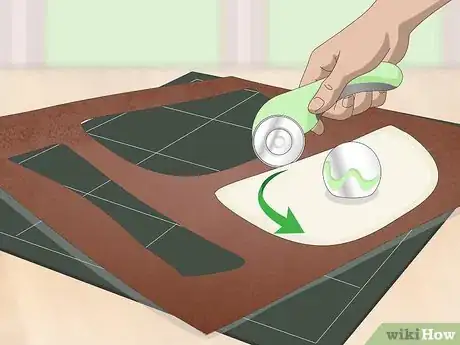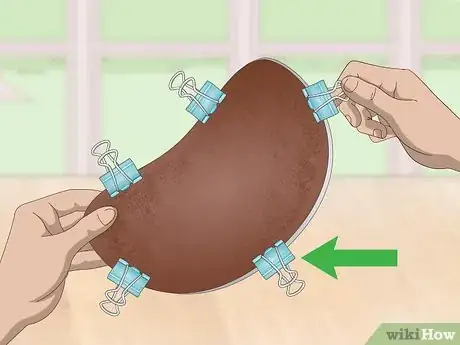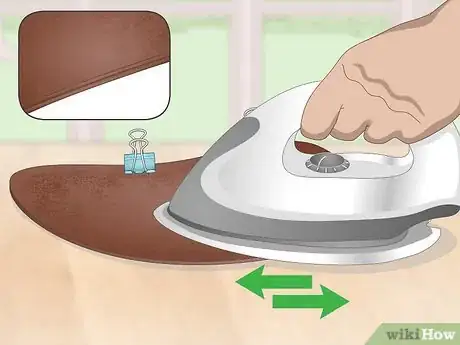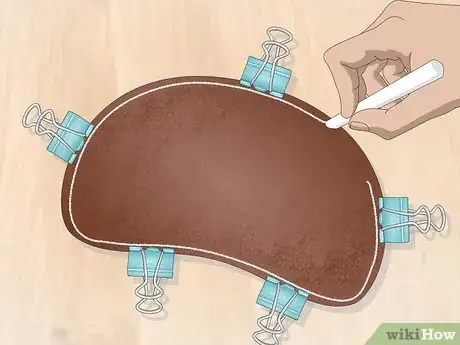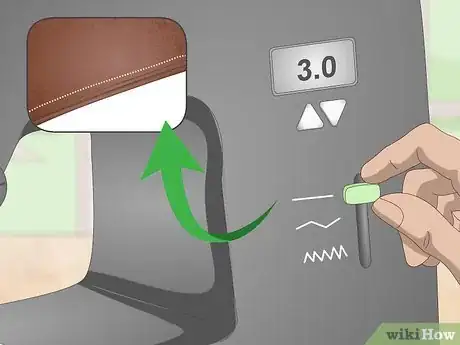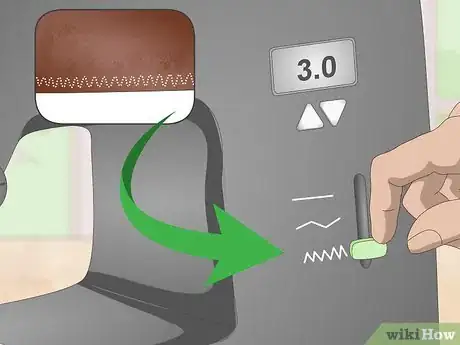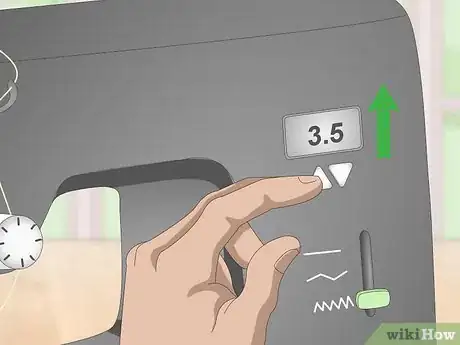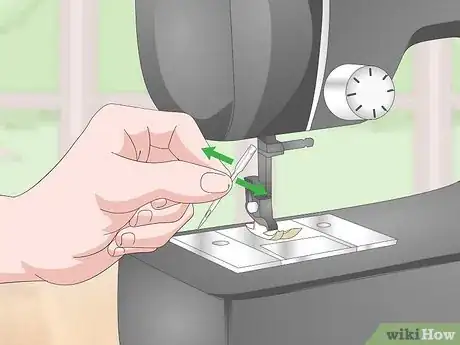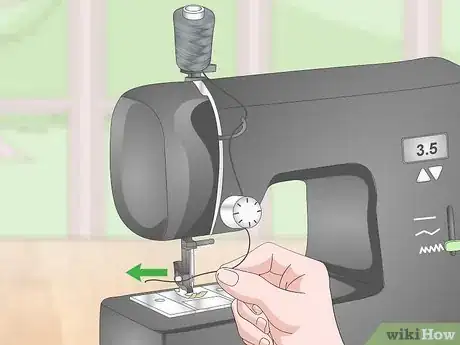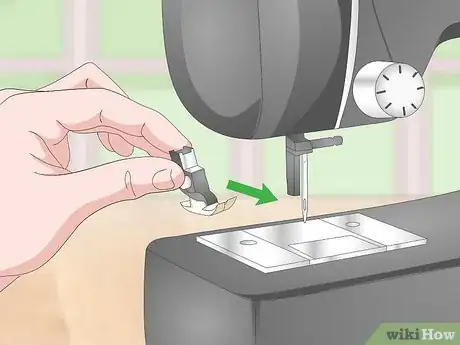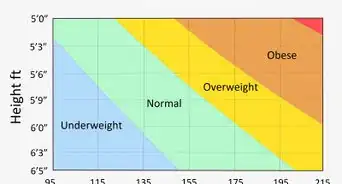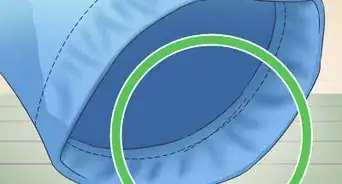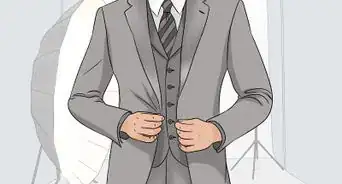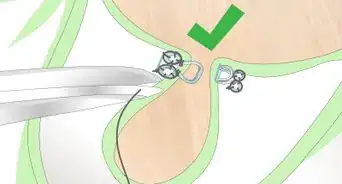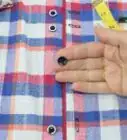This article was co-authored by Mia Danilowicz. Mia Danilowicz is a Master Tailor who works onset and on the red carpet in Los Angeles, California. With over a decade of experience, Mia specializes in bridal and gown couturier fittings, garment reconstruction, and custom design. Mia has worked at the Oscars, Grammys, SAG Awards, and Golden Globes. Her clients include a long list of entertainment and fashion industry headliners, major fashion magazines, luxury consumer brands, and popular media. Mia was trained at the Fashion Institute of Design and Merchandising and received her AA in Fashion Design and BS in Business Management.
This article has been viewed 19,202 times.
Fake leather is a great alternative to real leather, which can be quite expensive and difficult to sew. However, sewing fake leather comes with some special challenges of its own. You cannot pin and cut fake leather the same way that you would with most fabrics. You need to adjust your sewing machine before sewing fake leather. There are also some special tools and techniques you can try to get the best results possible!
Steps
Cutting Fake Leather
-
1Place weights on top of the pattern pieces before you cut the fabric. If you are using a pattern to sew fake leather, you will need to use the pieces as your guides for cutting. To avoid damaging fake leather fabric, use paper weights to hold the pattern pieces in place on top of the fake leather fabric. You can use paper weights, clean rocks, or any other small, heavy item to hold the pattern pieces in place.[1]
- Make sure that you use plenty of weights to hold down all of the edges of the pattern pieces. Place a weight every 3 to 4 inches (7.6 to 10.2 cm) along the edges of the pattern pieces.
-
2Cut fake leather with a rotary cutter and cutting mat. It is important to have a sharp tool to cut fake leather since it tends to be thick. Place the leather on a plastic cutting mat and use a rotary cutting tool to cut the fake leather along the edges of the pattern.[2]
- You use a rotary cutting tool similar to how you would cut a pizza. Hold the rotary tool by the handle and roll the blade over the areas of the fake leather fabric you want to cut.
- If you do not have a rotary cutting tool, then you can use a pair of very sharp scissors. Just be careful not to move the weights when you cut the fabric. Hold the scissors close to the table or other surface that the fake leather is resting on.
Advertisement -
3Use binder clips to hold the cut fake leather pieces together. After you cut the fake leather into the shapes required for your sewing pattern, use binder clips to connect the pieces as indicated by the pattern. Binder clips will not penetrate the fabric the way that pins will, so you will be less likely to damage the fabric.[3]
- Place a binder clip about every 2 to 3 inches (5.1 to 7.6 cm) along the edges of the fabric pieces.
- You will need to remove the binder clips before you sew each area of the fake leather.
-
4Iron the seams using the synthetic setting. Ironing down folded edges of the fake leather fabric before you sew them may help to make it easier to sew fake leather fabric. If your iron has a synthetic setting, set it to that. You should also place a t-shirt or thin towel over the fake leather fabric before you sew.[4]
- If your iron does not have a synthetic setting, then use the lowest possible setting.
-
5Plan where you will sew and sew only once across an area. Fake leather material will tear if you sew over it too many times, so it is best to only sew across an area of the fabric 1 time. Identify where you want your stitches to go before you start sewing.[5]
- Try using chalk to mark the areas where you want to stitch the fake leather.
- Do not backstitch with fake leather. Even this small amount of extra stitching can weaken the fabric.
-
6Sew to the end of the fabric and tie the thread in a knot. When you have reached the final edge of your leather fabric, sew all the way to the end of the fabric and off the edge. Then, cut the thread with several inches of excess thread remaining and tie the ends of the thread together twice to secure the last stitch.
Adjusting Your Sewing Machine Settings
-
1Set your machine to a straight stitch for seams. Straight stitches work best for sewing 2 pieces of fake leather fabric together. The straight stitch setting is usually number 1 on sewing machines, but consult your sewing machine’s instructions.[6]
- You can also use the straight stitch to sew hems.
-
2Choose a zigzag stitch for hems. The zigzag stitch is a good option for finishing edges, such as hems on leather fabric. The stitch will cover more area of the fake leather fabric, so it will hold the edge of the fabric more securely. If you prefer the look of the zigzag stitch, use it to sew your hems.[7]
- Consult your sewing machine for instructions on how to set it to the zigzag stitch.
-
3Widen the stitch length to at least 3.5. Having the stitches too close together may stress the fabric and lead to tears. A wider stitch length will help to prevent the needle from damaging your fake leather fabric. Locate the stitch width dial or control button on your sewing machine and adjust the stitch length so that it is on one of the wider settings, 3.5 or higher.[8]
- Consult your sewing machine’s manual for specific instructions on how to adjust the stitch width.
-
4Loosen the tension on your thread to make it easier to sew. Too much tension on your thread can make it difficult to sew through fake leather fabric, and you may also end up breaking your thread. To make it easier to sew the fake leather fabric, adjust the thread tension on your sewing machine by turning the dial at the top of the machine near the area where the thread feeds through. Turn the dial to the left by about 1 quarter to 1 half of a turn to loosen the thread.[9]
- Test the stitches on a piece of scrap fabric to see if you need to adjust the tension more. If the thread bunches up on the back of the fabric, you have loosened the tension too much.
Making Fake Leather Easier to Sew
-
1Install a new needle before and after sewing fake leather. The thickness of this fabric will wear down the point of your sewing machine needle more quickly than other fabrics, so it is important to install a new needle before you start a sewing project that uses fake leather and after you finish the project as well.[10]
- Follow your sewing machine’s instructions for installing a new needle.
-
2Use a denim sewing machine needle with a thicker fake leather fabric. Depending on the thickness of your fake leather, it may be hard for a standard sewing machine needle to get through it. Using a standard needle with extra thick fake leather may even damage your machine or cause the needle to break. Purchase a denim sewing machine needle for use with thicker fabrics to make this easier.[11]
- There are sewing machine needles meant for sewing leather, but a denim needle will work better with fake leather.
-
3Thread the sewing machine with a heavy-duty thread. To ensure strong stitches in fake leather fabric, make sure to use thread that is thick enough to hold the leather fabric together.[12] You can purchase a thread meant for working thicker materials, such as denim thread or embroidery thread.[13]
- The color of the thread should also match the fake leather fabric. For example, if the fabric is brown, then choose a brown thread.
-
4Purchase a non-stick presser foot. Fake leather may stick to a standard metal presser foot. To help the presser foot glide over the fabric, use a presser foot that is coated with Teflon or a roller presser foot.[14]
- Check your local craft supply store for a non-stick presser foot.
- Follow your machine's instructions for installing the presser foot.
-
5Use parchment or wax paper to help the presser foot glide. You can also use parchment or wax paper to help the metal presser foot glide over your fabric. Place a sheet of wax paper or parchment over the area of the fake leather fabric you are going to sew. Then, slide the fabric and the wax or parchment paper under your sewing machine’s presser foot and begin sewing. Sew through the paper and fabric at the same time. After you are done sewing, tear the paper away from the stitches.[15]
- This is a good option if you do not have a special presser foot to help the fake leather fabric glide under the presser foot.
Expert Q&A
-
QuestionWhat type of sewing foot should I use?
 Mia DanilowiczMia Danilowicz is a Master Tailor who works onset and on the red carpet in Los Angeles, California. With over a decade of experience, Mia specializes in bridal and gown couturier fittings, garment reconstruction, and custom design. Mia has worked at the Oscars, Grammys, SAG Awards, and Golden Globes. Her clients include a long list of entertainment and fashion industry headliners, major fashion magazines, luxury consumer brands, and popular media. Mia was trained at the Fashion Institute of Design and Merchandising and received her AA in Fashion Design and BS in Business Management.
Mia DanilowiczMia Danilowicz is a Master Tailor who works onset and on the red carpet in Los Angeles, California. With over a decade of experience, Mia specializes in bridal and gown couturier fittings, garment reconstruction, and custom design. Mia has worked at the Oscars, Grammys, SAG Awards, and Golden Globes. Her clients include a long list of entertainment and fashion industry headliners, major fashion magazines, luxury consumer brands, and popular media. Mia was trained at the Fashion Institute of Design and Merchandising and received her AA in Fashion Design and BS in Business Management.
Master Tailor The most important change you need to make is to switch to a Teflon Sewing foot. A Teflon foot allows the fabric to slide through the machine. One hack I have used in a pinch is to add a piece of scotch tape to the bottom of my existing foot if you do not have time to get a Teflon one.
The most important change you need to make is to switch to a Teflon Sewing foot. A Teflon foot allows the fabric to slide through the machine. One hack I have used in a pinch is to add a piece of scotch tape to the bottom of my existing foot if you do not have time to get a Teflon one. -
QuestionWhat kind of needle and thread works best for fake leather?
 Mia DanilowiczMia Danilowicz is a Master Tailor who works onset and on the red carpet in Los Angeles, California. With over a decade of experience, Mia specializes in bridal and gown couturier fittings, garment reconstruction, and custom design. Mia has worked at the Oscars, Grammys, SAG Awards, and Golden Globes. Her clients include a long list of entertainment and fashion industry headliners, major fashion magazines, luxury consumer brands, and popular media. Mia was trained at the Fashion Institute of Design and Merchandising and received her AA in Fashion Design and BS in Business Management.
Mia DanilowiczMia Danilowicz is a Master Tailor who works onset and on the red carpet in Los Angeles, California. With over a decade of experience, Mia specializes in bridal and gown couturier fittings, garment reconstruction, and custom design. Mia has worked at the Oscars, Grammys, SAG Awards, and Golden Globes. Her clients include a long list of entertainment and fashion industry headliners, major fashion magazines, luxury consumer brands, and popular media. Mia was trained at the Fashion Institute of Design and Merchandising and received her AA in Fashion Design and BS in Business Management.
Master Tailor Switch your machine needle to a leather machine needle. You will also need to use a thicker thread suited for heavier weight material. Keep in mind, as you sew fake leather you only get one chance to make a stitch as any mistakes will show. Do practice seams on scraps to get the hang of it.
Switch your machine needle to a leather machine needle. You will also need to use a thicker thread suited for heavier weight material. Keep in mind, as you sew fake leather you only get one chance to make a stitch as any mistakes will show. Do practice seams on scraps to get the hang of it.
References
- ↑ https://sew4home.com/tips-resources/sewing-tips-tricks/tips-sewing-faux-leather
- ↑ https://sew4home.com/tips-resources/sewing-tips-tricks/tips-sewing-faux-leather
- ↑ https://sew4home.com/tips-resources/sewing-tips-tricks/tips-sewing-faux-leather
- ↑ https://sew4home.com/tips-resources/sewing-tips-tricks/tips-sewing-faux-leather
- ↑ https://sewsweetness.com/2014/12/sew-faux-leather.html
- ↑ https://sew4home.com/tips-resources/sewing-tips-tricks/tips-sewing-faux-leather
- ↑ https://sew4home.com/tips-resources/sewing-tips-tricks/tips-sewing-faux-leather
- ↑ https://sewsweetness.com/2014/12/sew-faux-leather.html
- ↑ http://www.threadsmagazine.com/2014/01/06/video-quick-tip-how-to-sew-with-faux-leather
- ↑ https://sew4home.com/tips-resources/sewing-tips-tricks/tips-sewing-faux-leather
- ↑ https://sew4home.com/tips-resources/sewing-tips-tricks/tips-sewing-faux-leather
- ↑ Mia Danilowicz. Master Tailor. Expert Interview. 8 January 2021.
- ↑ https://sewsweetness.com/2014/12/sew-faux-leather.html
- ↑ https://sew4home.com/tips-resources/sewing-tips-tricks/tips-sewing-faux-leather
- ↑ https://sew4home.com/tips-resources/sewing-tips-tricks/tips-sewing-faux-leather

